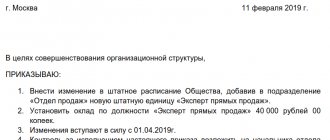There is much in common between the terms “dismissal” and “dismissal”. Both of these mean the termination of the existing employment relationship with the employee. However, the exemption is most often used in government agencies and for positions of high-ranking managers in commercial companies. In addition, upon dismissal from a position, it is possible not only to dismiss the employee, but also to demote the employee based on the results of certification or transfer him to a lower position by decision of the employer.
Also see:
- How to fire a manager (general director): grounds, procedure, features
- Drawing up a protocol on termination of powers of the director (sample 2020)
What the law says about dismissal from office
When considering the concept of “dismissal from a position,” in practice it is most often understood as the dismissal of a high-ranking government official or top manager of a commercial structure for guilty actions that caused damage to a company or institution. The following may serve as grounds for termination of employment relations (Article 278 of the Labor Code of the Russian Federation):
- removal from office due to bankruptcy;
- adoption by a co-owner or founders of a decision to dismiss a manager from office;
- other grounds provided for in the employment contract.
In most cases, the reason for such a decision is improper performance or systematic failure by a high-ranking employee to fulfill his duties. For example, the circumstances enshrined in the employment contract and sufficient to dismiss from a position may include:
- failure to conduct audits;
- failure to comply with decisions of the company’s authorized management body;
- exceeding official authority during decision-making, allowing abuse;
- violation through the fault of the manager of labor legislation, as well as labor protection standards.
Thus, dismissal from a position involves termination of employment relations or demotion at the initiative of the administration (owners). Moreover, these can be both the specific grounds given above and those specified in Art. 81 Labor Code of the Russian Federation.
But this does not mean that an employee cannot ask to be relieved of his position on his own initiative - for example, due to deteriorating health, retirement or moving to another city.
There are also frequent cases of termination of cooperation with top managers by agreement of the parties.
How to punish for violations
A citizen has the right not to appear at the place and time specified in the summons only for a good reason. They are listed in paragraph 2 of Art. 7 53-FZ dated March 28, 1998. There is liability for absence from military training. But it is not as strict as for evading conscription. According to Art. 21 of the Administrative Code, failure by citizens to fulfill military registration obligations entails administrative liability. Those who do not want to participate in the testing sessions without a good reason will face a fine of 100 to 500 rubles.
The law also provides for administrative liability for the employer for failure to notify the employee of the call-up. The amount of the fine (Article 21.2 of the Administrative Code) is from 500 to 1000 rubles. Production conditions are not grounds for preventing an employee from fulfilling his military duty.
Why are people released from positions in government agencies?
For state-owned enterprises, Decree of the Government of the Russian Federation dated March 16, 2000 No. 234 provides additional grounds for termination of the powers of managers. These include:
- systematic failure to achieve economic efficiency indicators;
- failure to comply with decisions of the Government of the Russian Federation;
- concluding transactions on the use of enterprise property in violation of legal requirements;
- occurrence of salary arrears for a period of more than 3 months, etc.
In addition, for civil servants, grounds for dismissal (dismissal from office) are provided in Art. 13.1 of the Federal Law of December 25, 2008 No. 273-FZ:
- failure to take measures to prevent conflicts of interest;
- concealing the income of a civil servant;
- participation in commercial activities;
- participation in the management of foreign non-profit organizations.
Procedure
Let’s say an employer learns that a criminal case has been initiated against his employee. What should he do in this case? If we do not take into account crimes committed by teachers and allowing for a simplified removal procedure, then we should proceed as follows:
- Wait until you receive a court decision . Moreover, such removal from office is temporary. The decision is made by the judge no later than 2 days from the receipt of the relevant petition from the investigator or inquiry officer. Afterwards, it must be sent in writing to the place of work (clause 3 of Article 114 of the Code of Criminal Procedure of the Russian Federation). The document indicates the nature of the crime, information about the accused, allowing him to be identified among the employees of the enterprise.
- Issue a removal order . It contains information about the employee, the grounds for removal and the time (according to the length of time under investigation).
This will complete the suspension procedure, however, the employer must remember that information about the suspension must be correctly displayed in the timesheet. Since the employee’s salary is not retained during such a suspension, codes “NB” or “35” are entered in the timesheet throughout the entire period.
By the way, instead of earnings, the accused receives a monthly allowance (clause 6 of Article 114 of the Code of Criminal Procedure of the Russian Federation). The terms and specifics of his appointment are specified in clause 31 of the Decree of the Government of the Russian Federation No. 1240 of December 1, 2012.
Procedure for dismissal from office
In general, the procedure for dismissal from a position is identical to dismissal on the grounds provided for by the Labor Code of the Russian Federation. But instead of terminating the employment relationship, the employee may be transferred to a lower position.
The text of the employee’s application depends on the chosen option of voluntary release.
In the text of the application they write “... I ask you to relieve me from my position...” and indicate the date that will be the last working day. If a transfer to a lower position is intended, then additionally indicate “... and transfer to the position...” with the name of the new position.
The application in case of dismissal must be written taking into account the period of service established in Art. 80 Labor Code of the Russian Federation.
If a high-ranking employee is removed from his position for a disciplinary offense, then first:
- collect documents proving guilt;
- require written explanations from him.
After this, a dismissal order is immediately issued, taking into account the timing of the disciplinary sanction.
Another possible reason for losing a job could be the founders' dissatisfaction with the employee's work. Then the basis for removing powers is the decision of the general meeting or the owner of the business.
In the event of termination of the employment relationship after removal from position, the order for dismissal from the position held is identical to the order for dismissal. It can also be compiled in any form or using form No. T-8.
If a decision is made to transfer to a lower position, a transfer order (free form or form No. T-5) is drawn up and, at the same time, an additional agreement to the employment contract, since such a transfer is possible only with the consent of the employee.
Further, the procedure for dismissal or transfer is no different from the standard one: filling out a work book, personal card, calculation and issuance of documents upon termination of an employment contract.
Read also
29.09.2018
Conditions for removal
It turns out that the employer himself cannot remove an employee against whom a criminal case has been opened. If he draws up a corresponding order and deprives the employee of earnings simply at his own discretion, then the latter, through a judicial procedure, will be able not only to be reinstated in his position, but also to receive wages for the entire period of illegal removal. Compensations are also possible.
It turns out that in order to remove a person from his position, the employer must wait for a court decision? In practice, there may be cases when this happens earlier. Only the initiator of such a “freeze” is not the employer, but the judge. Those. until the relevant decision is received.
Appointment to office
The basis in question is often confused with the fact that an order is issued regarding the hiring of a person. Some authors say that the concept concerns labor relations with the management of the company or its representative office.
They cite civil legislation to substantiate their point of view. It reflects that the management of the branch or representative office must be appointed to the position by the organization. The basis is considered to be a power of attorney.
The norms of civil law do not reflect how labor relations are established between the organization and the director of the representative office. It only reflects that the management of the main company controls the activities of this manager. There are several ways to obtain a position. Including:
- Conducting a competition.
- Elections.
- Other procedures established in a particular society.
Features of order execution
Depending on who is the initiator of the termination of work combining positions, the following reasons for drawing up the order are distinguished:
- employee statement;
- notice issued by the employer.
The employee’s application is submitted not according to the general rules of labor legislation (which provide for a period of 14 calendar days), but 3 working days in advance. The application must indicate:
- the reason for reluctance to perform assigned duties;
- request to be released from a part-time position.
The application can be submitted to the manager's reception or office so that it is assigned an incoming number and the date of acceptance is stamped. If for some reason the application is not accepted, it must be sent to the official address of the employer by registered mail with notification.
If an employer wants to stop an employee from combining job responsibilities, he must give the employee 3 working days' notice. This notice must be given to the employee against signature indicating the date of its receipt.
Within 3 working days after receiving an application from the employee (or notification from the employer), a document on canceling the combination must be drawn up. The order must include the following elements:
- name of the employing organization;
- full name of the order;
- date of signing, serial number of the document;
- indication of the reason for canceling the combination (“in connection with the end of the sick leave”, “in connection with occupying a vacant position”, etc.);
- Full name of the employee holding a part-time position;
- the date from which the cancellation is established;
- instructions to cancel the surcharge;
- grounds for termination of the combination (notification from the employer or application from the employee);
- manager's signature;
- the date the employee familiarized himself with the order, his signature with a transcript.
On behalf of the manager, the document can be signed by his deputy.
If an employee refuses to accept such a document, an act of refusal of the person to sign can be drawn up. The act is drawn up in the presence of this employee, signed by the manager and at least two other employees. It will serve as proof that the worker is aware of the fact that the combination of positions has been cancelled.
Based on the order, an additional agreement is drawn up on the termination of additional work activities and additional payments. The order and additional agreement must be submitted to the accounting service so that the bonus established for the employee is no longer accrued or paid.
The order to cancel the combination may not contain instructions to stop payments for additional duties. In this case, the surcharge must be removed by a separate order, which is drawn up on the same date as the main document. The employee must also be familiarized with such an order against signature.
Release of the General Director
There are several reasons for the dismissal of the CEO.
- end of contract;
- committing unlawful acts;
- the will of the employee;
- change of owner of the company.
Labor relations can be terminated at the initiative of the founders of the organization. This option is considered the simplest. The sequence of actions is reflected in labor legislation.
The dismissal process is carried out on a general basis. They are reflected in Article 77 of the Labor Code. In addition, the basis may be the termination of the company's activities due to insolvency. When dismissing, you must comply with the law.
The basis may be a decision made at a general meeting of founders. It depends on the form of ownership of the enterprise. When these persons have given their consent, the process continues in the standard sequence.
Regulatory framework and features
The provisions that regulate combination and part-time work are presented in the Labor Code of the Russian Federation - these are articles 60.1 (part-time work) and 60.2 (combination).
Labor Code of the Russian Federation
First you need to understand what is meant by combination.
Combination is work that a person does in conjunction with his main activity within the working day for the same or another position for additional money.
At the same time, the quality of the main work should not suffer.
Not to be confused with part-time work, which is regular work in your free time from your main activity, and possibly with another employer.
Article 60 of the Labor Code of the Russian Federation provides detailed information on this topic.
Conditions
To register a combination, the following conditions are required:
- The appointed employee must have experience and skills in the combined work.
- Combination is possible if a person is able to perform a specified range of tasks during working hours on his territory, without compromising his main job.
- The staffing table contains a combined position.
- The work is performed by mutual agreement of the parties.
- The work can be divided among several persons, and one person can combine several positions.
- Both parties can terminate this relationship by giving three days notice before the end.
Period for which the combination can be registered:
- A specific period can be selected with a start and end date.
- The period may be prescribed by a condition for termination, for example, the return to work of an absent person or a circumstance, for example, illness, business trip, study of the main employee.
- It is more economically feasible to combine some positions than to have a permanent person in it. In this case, the period can be determined as permanent.
Works to be combined:
- Work other than the main one. For example, a foreman combines the position of a driver, driving around objects independently and performing work transportation.
- Increasing the service area or increasing the volume of work on core activities. For example, an accountant combines the work of the chief accountant while he is on vacation.
In this case, when combining, the following payment conditions may be established:
- The surcharge can be set to a fixed amount.
- May be calculated as a percentage of the employee's daily earnings.
- It is set as a percentage of the hourly rate of the combined profession.
The Labor Code of the Russian Federation does not regulate the maximum standards for the minimum and maximum levels.
It only stipulates here that the amount of payments is limited to the savings in the wage fund of the unemployed rate and is established by agreement of the parties.
The basis for completing the combination can be:
- The end of the period established by the documents.
- An employee was hired for a vacant position.
- The employer no longer needs this work.
- The employee is not satisfied with such work under the agreed conditions, and he does not want to do it anymore.
How is dismissal carried out under a fixed-term employment contract? Find out from our article.
Is it possible to cancel an employment contract at the initiative of the employee? Read.
Storing an order
For each category of documents, the legislation of the Russian Federation establishes certain storage periods. The order on the removal of obligations for the position being filled contains information on personnel, as it establishes:
According to the provisions of the List approved by the Order of the Ministry of Culture of Russia dated August 25, 2010 (No. 558), the employer stores any document on personnel for 75 years after its signing.






